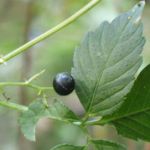| Common Name: |
Gospel Herb |
| Other Names: |
Sweet Tea Vine |
| Botanical Name: |
Gynostemma pentaphyllum |
| Genus: |
Gynostemma |
| Family: |
Cucurbitaceae |
| Native Location: |
Japan |
| Cultivation: |
Moist, well-drained soil in partial shade. |
| Propagation: |
By seed sown in spring, soaked for 24 hours before sowing. |
| Harvest: |
Plants are cut in summer and dried for use in capsules, decoctions, extracts, tablets, and teabags. |
| Height: |
8m (25ft) |
| Width: |
Indefinite |
| Hardiness: |
Z8 |
| Parts Used: |
Whole plant. |
| Properties: |
A tonic herb that improves the circulation, stimulates liver function, strengthens the immune and nervous systems, and reduces blood sugar and cholesterol levels. It also has sedative effects, relaxing spasms and lowering blood pressure. |
| Medicinal Uses: |
Internally for nervous tension and exhaustion, peptic ulcer, asthma, bronchitis, diabetes, cardiovascular disease, and cancer. |
| Economic Uses: |
Used in anti-aging tonics and cosmetics. |
| Bibliography: |
Encylopedia of Herbs by Deni Brown Copyright ©: 1995, 2001 Dorling Kindersley Limited pp 229-230
|

